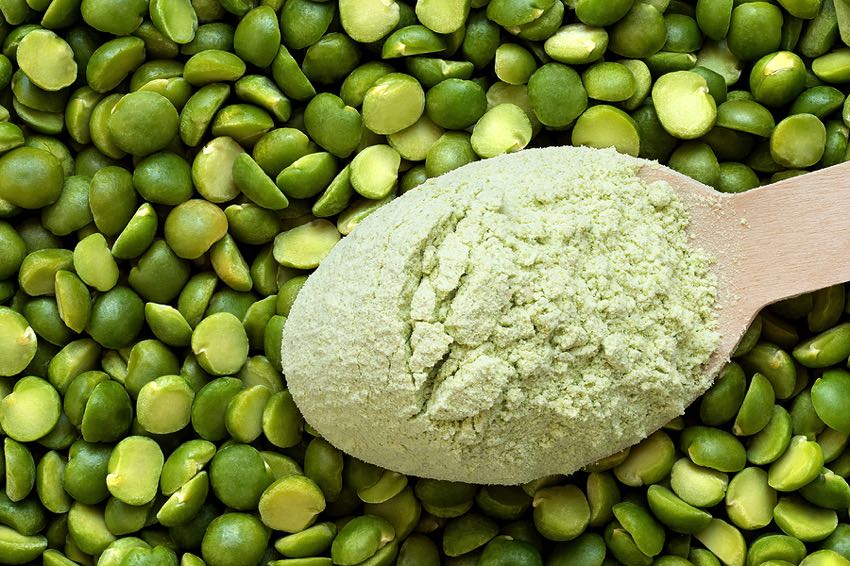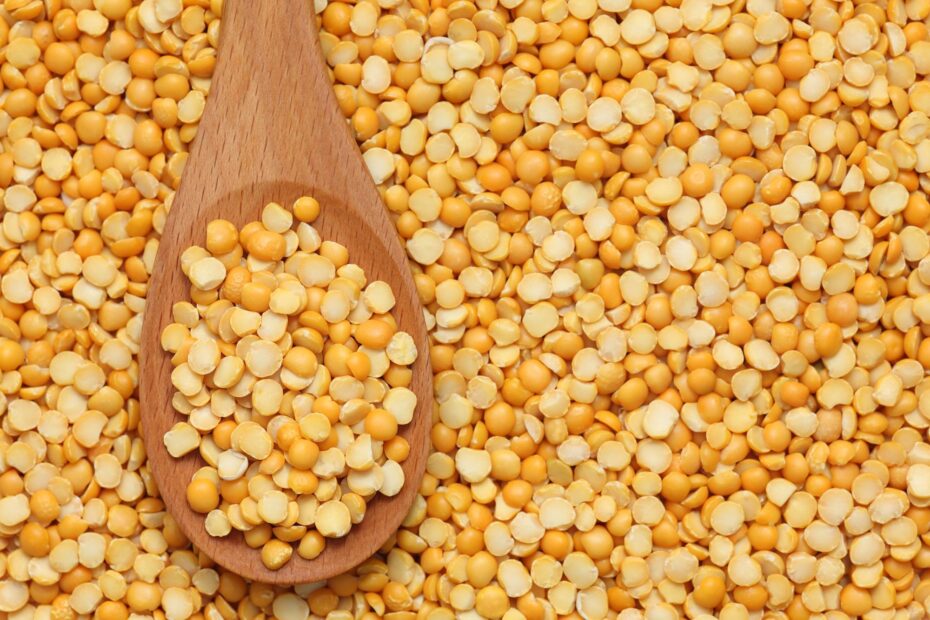What is pea protein?
Pea protein is a plant-based protein derived from yellow peas (Pisum sativum). It is often used as a supplement for those seeking an alternative to animal-based proteins, making it popular among vegans, vegetarians, and individuals with lactose intolerance or other dietary restrictions.
How is pea protein derived?
Pea protein is derived from yellow peas through a multi-step process designed to isolate the protein. Here’s how the process generally works:
- Harvesting and Cleaning: Yellow peas are harvested, cleaned, and dried to remove any dirt or contaminants.
- Milling: The cleaned peas are then ground into a fine flour. This pea flour contains starch, fibre, and protein.
- Separation (Wet Fractionation):
- The pea flour is mixed with water, forming a slurry.
- A process called centrifugation is used to separate the protein from the starch and fibre. The starch and fibre are heavier and settle at the bottom, while the lighter protein remains in the liquid.
- Protein Isolation:
- The liquid containing the protein undergoes further purification to remove any remaining starch and fibre. This may involve filtration or additional centrifugation steps.
- At this point, the result is a protein-rich liquid called pea protein concentrate (which is about 70–80% protein) or it can be further refined into pea protein isolate (typically 85–90% protein).
- Drying: The liquid protein concentrate or isolate is then dried using a process like spray drying, which converts it into a fine powder.
- Final Processing: The pea protein powder may be flavoured, packaged, or blended with other ingredients depending on the intended use (e.g., protein powders, supplements, or food products).
Why people are consuming pea protein
Points put forward for pea protein:
Here are some key points being made about pea protein by the producers of the product:
- Nutritional Value: It is considered rich in essential amino acids, especially branched-chain amino acids (BCAAs), which are said to be important for muscle growth and recovery.
- Allergen-Friendly: Pea protein is free from common allergens such as gluten, soy, and dairy, therefore it said to be suitable for people with food allergies or sensitivities.
- Digestibility: It is known for being easy to digest compared to some other plant-based proteins like soy or wheat.
- Sustainability: Peas are relatively easy to grow and have a lower environmental impact compared to animal-based protein sources.
- Uses: Pea protein is commonly found in protein powders, shakes, bars, and used as an ingredient in plant-based meat alternatives due to its texture and versatility. It’s a considered a great option for those looking for a clean, plant-based source of protein.
Here is the problem:
- Isolated Chemistry: Pea protein is isolated chemistry. The body is meant to consume foods as whole food. In the case of pea protein, the pea is split into parts and the individual part extracted and consumed instead of being consumed as a whole food/ It is in fact a highly processed food that may result in negative consequences after continued consumption.
- Digestive Issues: Pea protein, though said to be more easily digestible can cause digestive discomfort in certain individuals, leading to bloating or gas. This is due to the presence of certain compounds in peas, such as oligosaccharides, which can ferment in the digestive tract.
- Anti-Nutrients: Peas naturally contain compounds called anti-nutrients, such as phytic acid and lectins, which can interfere with the absorption of essential minerals like iron, calcium, and zinc. Even after processing methods these compounds may still remain in the final product.
- Potential for Heavy Metal Contamination: Pea protein may contain trace amounts of heavy metals such as lead, arsenic, or cadmium. These are naturally absorbed by plants from the soil.

Expanding on the issue of “isolated chemistry”
An important critique of should be focused on the way modern food and supplement production often isolates specific components of a natural food source, like pea protein, to focus on its benefits while ignoring the complexity and balance of whole foods in nature. Here’s why this is a concern:
-
Whole Foods vs. Isolated Nutrients
- In nature, nutrients are found in a synergistic balance within whole foods. The fibre, minerals, antioxidants, and phytonutrients present in peas or other plants work together to promote health. Isolating just one element, like protein, disrupts this balance and may reduce the overall nutritional benefits.
- For example, pea protein isolate removes much of the fibre, carbohydrates, and some micronutrients found in whole peas. While the protein concentration increases, other beneficial compounds are lost or diminished.
-
Loss of Nutritional Complexity
- Isolating substances can lead to what some call reductionism, where the focus is placed on a single nutrient or compound (like protein) without considering the complex interactions that naturally occur in whole foods.
- Nature provides a range of bioactive compounds in whole foods that support digestion, metabolism, and nutrient absorption. When we isolate one substance, we lose that holistic nutritional complexity. For instance, fibre in peas helps regulate blood sugar and promotes gut health, but it’s absent in isolated pea protein.
-
Digestibility and Bioavailability
- Whole foods are often more easily digested and absorbed because of their complete nutritional profile. Isolated substances like pea protein, though convenient, may lack the natural substances, fibre, or co-factors found in the whole food, potentially making them harder for the body to process optimally.
- Additionally, some isolated proteins or nutrients may cause digestive discomfort (such as bloating or gas) because they’re not accompanied by the natural compounds in whole peas that help moderate their effects.
-
Natural Context and Evolution
- Our bodies evolved to process whole foods, not isolated components. For most of human history, we consumed foods in their natural state, with their full array of nutrients. Modern isolation techniques are a relatively recent invention, and our bodies may not respond as well to these stripped-down versions of food components.
- For example, consuming a protein powder might not provide the same long-term benefits as eating a variety of legumes, grains, and other protein sources in their whole form. Our bodies are designed to break down, absorb, and utilise nutrients from complex foods, not isolated fractions.
-
Potential Imbalance
- Relying heavily on isolated proteins or other isolated nutrients can lead to imbalances in the diet. For example, focusing on protein isolates might reduce the intake of other essential nutrients like healthy fats or complex carbohydrates, which are necessary for a balanced diet.
-
Nature’s Built-in Safeguards
- Whole foods often come with built-in safeguards that help prevent overconsumption of any single component. For instance, the fibre in peas can make them more filling, so you’re less likely to overeat. Isolating the protein removes that natural regulation mechanism, potentially encouraging overconsumption or imbalance in the diet.
In contrast, whole-food nutrition emphasises the wisdom of nature, where food is seen as a complex matrix of interacting compounds, each playing a role in overall health. Isolating and consuming single nutrients, whether proteins, “vitamins”, or minerals, can sometimes provide specific benefits but may overlook the broader picture of nutrition and the way our bodies are designed to process foods in their complete form.
References:
– Pea proteins: Variation, composition, genetics, and functional properties. April 2021 Cereal Chemistry 99(2) DOI:10.1002/cche.10439. Authors: Sintayehu Daba – Purdue University, C.f. Morris – Washington State University
– Composition, physicochemical properties of pea protein and its application in functional foods. PMID: 31429319 DOI: 10.1080/10408398.2019.1651248. Z X Lu, J F He, Y C Zhang, D J Bing
– Foods. 2023 Jul; 12(13): 2527. Published online 2023 Jun 29. doi: 10.3390/foods12132527. A Comprehensive Review of Pea (Pisum sativum L.): Chemical Composition, Processing, Health Benefits, and Food Applications. Ding-Tao Wu, Wen-Xing Li, Jia-Jia Wan, Yi-Chen Hu Ren-You Gan and Liang Zou
This article is copyrighted by Ital is Vital, 2025. Want to re-post this article? Visit our guidelines.
DISCLAIMER: THIS WEBSITE DOES NOT PROVIDE MEDICAL ADVICE
The information, including but not limited to, text, graphics, images and other material contained on this website are for informational purposes only. The purpose of this website is to promote broad consumer understanding and knowledge of various health topics. It is not intended to be a substitute for professional medical advice, diagnosis or treatment. Always seek the advice of your physician or other qualified health care provider with any questions you may have regarding a medical condition or treatment and before undertaking a new health care regimen, and never disregard professional medical advice or delay in seeking it because of something you have read on this website.
